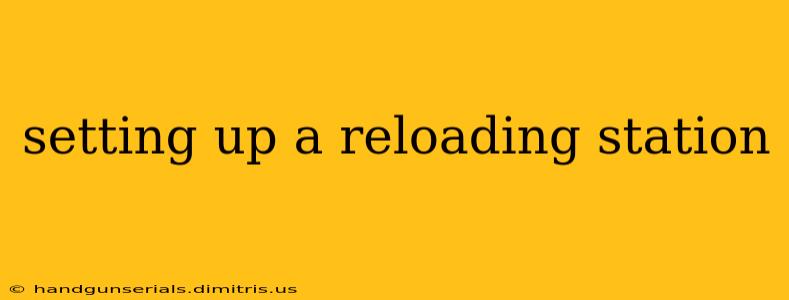Reloading ammunition can be a rewarding and cost-effective hobby, allowing you to tailor your ammunition to your specific needs and preferences. However, setting up a proper reloading station requires careful planning and attention to detail. This comprehensive guide will walk you through the process, covering everything from choosing the right location to maintaining your equipment.
Choosing Your Reloading Station Location
The first step is selecting an appropriate location for your reloading station. This space should be:
- Well-ventilated: Reloading generates powder dust, which can be irritating and potentially harmful if inhaled. A dedicated ventilation system or an open window with a good breeze is essential.
- Dedicated workspace: Avoid setting up your reloading station in a high-traffic area. A dedicated workspace minimizes the risk of accidental spills or disruptions. A sturdy table is crucial for stability.
- Properly lit: Good lighting is essential for accurate case preparation and component handling. Consider using a task lamp in addition to ambient lighting.
- Clean and organized: A clean and organized workspace prevents accidents and makes the reloading process more efficient.
Essential Reloading Equipment
Once you've chosen your location, it's time to gather the necessary equipment. This includes:
- Press: The heart of your reloading station, the press is used to size cases, prime primers, and seat bullets. There are various types, including single-stage, progressive, and turret presses, each with its own advantages and disadvantages.
- Dies: These are essential for shaping and sizing cases, seating primers, and seating bullets. You'll need a specific set of dies for each caliber you intend to reload.
- Powder measure: Accurately measuring gunpowder is critical for safety and consistent performance. There are various types of powder measures, from simple scoops to more precise electronic dispensers.
- Scale: A scale is used to weigh powder charges, ensuring consistency and preventing dangerous overcharges. A digital scale is recommended for accuracy.
- Case trimmer: Cases can become slightly longer after repeated firings, affecting the accuracy of your ammunition. A case trimmer ensures your cases are the correct length.
- Primer seating tool: This tool seats primers into the primer pockets of the cases.
- Bullet puller: This tool is used to remove bullets from cases, allowing you to reuse components or correct mistakes.
- Case cleaning supplies: Regularly cleaning your cases helps ensure optimal performance. This includes brushes, ultrasonic cleaners, and cleaning solutions.
- Safety equipment: This is perhaps the most crucial aspect. Always wear safety glasses, and consider using a shooting apron or other protective gear.
H3: Selecting the Right Press
The type of press you choose will depend on your reloading goals and volume.
- Single-stage presses: Ideal for beginners, these presses perform one operation at a time. They are simple to use and relatively inexpensive.
- Turret presses: Offer increased speed and efficiency compared to single-stage presses. They allow you to perform multiple operations in a single cycle.
- Progressive presses: The fastest and most efficient option, these presses can perform several operations with each stroke of the handle. However, they are more complex and require more experience.
Setting Up Your Reloading Station: A Step-by-Step Guide
- Organize your workspace: Arrange your equipment in a logical and efficient manner. Ensure you have enough space to work comfortably.
- Clean your workspace: Start with a clean workspace to prevent contamination of your components.
- Assemble your press: Carefully follow the manufacturer's instructions for assembling your reloading press.
- Mount your dies: Properly mounting your dies is crucial for safe and effective reloading. Consult your die manufacturer's instructions.
- Test your equipment: Before you begin reloading, test your equipment to ensure it's functioning correctly. Use dummy rounds for testing your press and dies.
- Organize your components: Keep your bullets, powder, primers, and cases organized and clearly labeled to avoid mistakes.
Safety First!
Reloading ammunition can be dangerous if not done properly. Always follow these safety guidelines:
- Always wear safety glasses: This is non-negotiable.
- Never overload your cases: Overloading can lead to catastrophic failures.
- Store your components safely: Keep your ammunition components separate from each other, and away from sources of ignition.
- Work in a well-ventilated area: Exhaust fumes and powder dust can be harmful to your health.
- Consult reloading manuals: Always refer to your reloading manuals for specific instructions and safety guidelines.
- Take your time: Rushing can lead to mistakes.
This guide provides a foundation for setting up a safe and efficient reloading station. Remember, consistent practice and adherence to safety protocols are key to successful and safe reloading. Further research and practice are essential to becoming proficient in this rewarding hobby.

